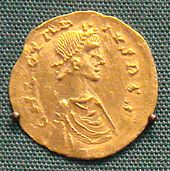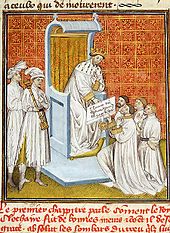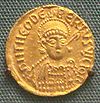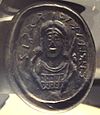- Chlothar II
-
Chlothar II (or Chlotar, Clothar, Clotaire, Chlotochar, or Hlothar, giving rise to Lothair; 584–629), called the Great (le Grand) or the Young (le Jeune), King of Neustria, and, from 613 to 629, King of all the Franks, was not yet born when his father, King Chilperic I died in 584. His mother, Fredegund, was regent until her death in 597, at which time the thirteen-year-old Chlothar began to rule for himself. As king, he continued his mother's feud with Brunhilda, queen of Austrasia, with equal viciousness and bloodshed.
Contents
Biography
In 599, he made war with his nephews, Theuderic II of Burgundy and Theudebert II of Austrasia, who defeated him at Dormelles (near Montereau). At this point, however, the two brothers took up arms against each other. In 605, he invaded Theuderic's kingdom, but did not subdue it. He remained often at war with Theuderic until the latter died in Metz in late 613 while preparing a campaign against him. At that time, Warnachar, mayor of the palace of Austrasia, and Rado, mayor of the palace of Burgundy, abandoned the cause of Brunhilda and her great-grandson, Sigebert II, and the entire realm was delivered into Chlothar's hands. Brunhilda and Sigebert met Chlothar's army on the Aisne, but the Patrician Aletheus, Duke Rocco, and Duke Sigvald deserted the host and the grand old woman and her king had to flee. They got as far as the Orbe, but Chlothar's minions caught up with them by the lake Neuchâtel. Both of them and Sigebert's younger brother Corbo were executed by Chlothar's orders.
In that year, Chlothar II became the first king of all the Franks since his grandfather Chlothar I died in 561 by ordering the murder of the infant Sigebert II (son of Theuderic), whom the aging Brunhilda had attempted to set on the thrones of Austrasia and Burgundy, causing a rebellion among the nobility. This led to the delivery of Brunhilda into Chlothar's hands, his thirst for vengeance leading to his formidable old aunt enduring the agony of the rack for three whole days, before suffering a horrific death, dragged to death by an unbroken horse.
In 614/615, Chlothar II promulgated the Edict of Paris, a sort of Frankish Magna Carta that reserved many rights to the Frankish nobles while it excluded Jews from all civil employment for the Crown.[1][2] The ban effectively placed all literacy in the Merovingian monarchy squarely under ecclesiastical control and also greatly pleased the nobles, from whose ranks the bishops were ordinarily exclusively drawn. Chlothar was induced by Warnachar and Rado to make the mayoralty of the palace a lifetime appointment at Bonneuil-sur-Marne, near Paris, in 617. By these actions, Chlothar lost his own legislative abilities and the great number of laws enacted in his reign are probably the result of the nobles' petitions, which the king had no authority not to heed.
In 623, he gave the kingdom of Austrasia to his young son Dagobert I. This was a political move as repayment for the support of Bishop Arnulf of Metz and Pepin I, mayor of the palace of Austrasia, the two leading Austrasian nobles, who were effectively granted semi-autonomy.
Chlothar II died in 629 after 45 years on the throne, longer than any other Merovingian dynast save for his grandfather Chlotar I, who ruled from 511 to 561. He left the crown greatly reduced in power and prepared the way for the rise of the mayors and the rois fainéants.
Family
The first spouse of Chlothar II was Haldetrude (ca. 575–604). She was the mother of Dagobert I. Chlothar's second spouse was Bertrada. His third spouse was Sichilde, who bore him Charibert II and a daughter, Oda.
References
Further reading
- Bachrach, Bernard S. (1972). Merovingian Military Organization, 481–751. Minneapolis: University of Minnesota Press, ISBN 0-81660-621-8.
- Geary, Patrick J. (1988). Before France and Germany: The Creation and Transformation of the Merovingian World. Oxford: Oxford University Press, ISBN 0-19504-458-4.
- James, Edward (1991). The Franks. London: Blackwell, ISBN 0-63114-872-8.
- Oman, Charles (1914). The Dark Ages, 476–918. London: Rivingtons.
- Wallace-Hadrill, J. M. (1962). The Long-Haired Kings, and Other Studies in Frankish History. London: Methuen.
- Wood, Ian N. (1994). The Merovingian Kingdoms, 450–751. London: Longman, ISBN 0-58221-878-0.
Chlothar IIBorn: 584 Died: 629Preceded by
Chilperic IKing of Neustria
584–613
with Fredegonde (584–597)Succeeded by
Dagobert I
in Austrasia & Neustria
Charibert II
in AquitaineVacant Title last held byClothar IKing of the Franks
613–629Merovingian monarchs Childeric I (457–481) • Clovis I (481–511) • Childebert I (511–558) • Chlodomer (511–524) • Theuderic I (511–533) • Theudebert I (533–548) • Theudebald (548–555) • Chlothar I the Old (511–561) • Charibert I (561–567) • Guntram (561–592) • Sigebert I (561–575) • Childebert II (575–595) • Theudebert II (595–612) • Theuderic II (612–613) • Sigebert II (613) • Chilperic I (561–584) • Chlothar II the Great (584–623) • Dagobert I (623–634) • Charibert II (629–632) • Chilperic (632) • Sigebert III (634–656) • Childebert the Adopted (656–661) • Clovis II (639–657) • Chlothar III (657–673) • Childeric II (662–675) • Theuderic III (675–691) • Dagobert II (675–679) • Clovis IV (691–695) • Childebert III the Just (695–711) • Dagobert III (711–715) • Chilperic II (715–721) • Chlothar IV (717–720) • Theuderic IV (721–737) • Childeric III (743–751)Categories:- Merovingian dynasty
- Frankish kings
- Kings of Burgundy
- 584 births
- 629 deaths
- Medieval child rulers
- 6th-century rulers in Europe
- 7th-century rulers in Europe
Wikimedia Foundation. 2010.





